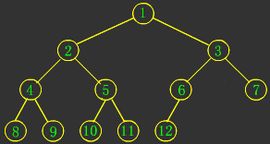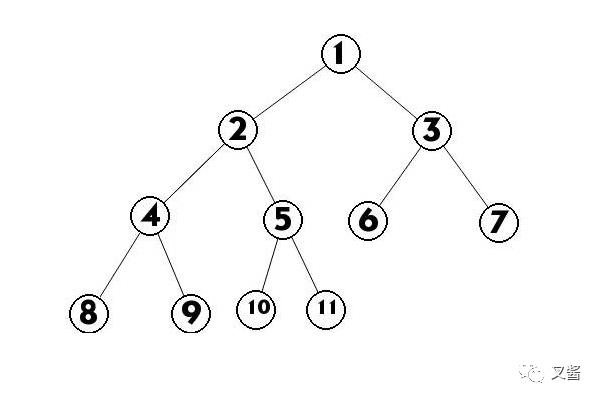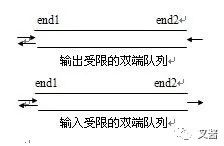二叉树 ,你是完整的吗?
Posted 叉酱
tags:
篇首语:本文由小常识网(cha138.com)小编为大家整理,主要介绍了二叉树 ,你是完整的吗?相关的知识,希望对你有一定的参考价值。





1、使用队列
2、遍历到任何一个节点,有右孩子没有左孩子直接返回false.
3、不违反2的情况下,当前节点左右两个孩子不全,标记为flag=1,从当前节点开始所有的节点均为叶子节点,即不能有孩子。若有返回false。

图片说明
1.输入
ABD###CE##F##
输出
层次遍历为:
A第1层
BC第2层
DEF第3层
不是完全二叉树
2.输入
ABD##E##C#F##
输出
层次遍历为:
A第1层
BC第2层
DEF第3层
不是完全二叉树
3.输入
ABD##E##CF##G##
输出
层次遍历为:
A第1层
BC第2层
DEFG第3层
是完全二叉树
4.输入
ABCE####D##
输出
ABCE####D##
层次遍历为:
A第1层
BD第2层
C第3层
E第4层
不是完全二叉树
typedef char TElemType;using namespace std;typedef struct BiTNode{TElemType data;//数据元素struct BiTNode *lchild,*rchild;//左、右孩子指针}BiTNode,*BiTree;void CreateBiTree(BiTree &T,TElemType definition){cin>>definition;if(definition == '#'){T=NULL;}else{T=(BiTNode*)malloc(sizeof(BiTNode));T->data=definition;CreateBiTree(T->lchild,definition);CreateBiTree(T->rchild,definition);}}void visit(BiTNode *T){cout<<T->data<<"";}//队列用于层次遍历typedef struct Queue{BiTNode *front;//队列头指针BiTNode *tail;//队列尾指针int size;//队列空间大小}Queue;//创建队列int InitQueue(Queue &Q){Q.front = (BiTNode*)malloc(INITQUEUE * sizeof(BiTNode));if(!Q.front){return 0;}Q.tail = Q.front;Q.size = INITQUEUE;return 1;}//判断队列是否为空bool EmptyQueue(Queue Q){if(Q.tail == Q.front){return true;}else{return false;}}//入队列int EnQueue(Queue &Q,BiTNode e){if((Q.tail - Q.front + INITQUEUE) % INITQUEUE == INITQUEUE - 1){return 0;}*Q.tail = e;Q.tail++;return 1;}//出队列int DeQueue(Queue &Q,BiTNode &e)//用e返回元素{if(Q.front == Q.tail){return 0;}e = *Q.front;Q.front++;return 1;}//判断是否为完全二叉树bool IfCompBinTree(BiTree T)//1是完全二叉树,0不是完全二叉树{if(T==NULL){return true;}Queue Q1;InitQueue(Q1);BiTNode *ch;ch = new BiTNode;EnQueue(Q1,*T);int flag=0; //标记 没有孩子或右孩子为空while(!EmptyQueue(Q1)){DeQueue(Q1,*ch);if(ch->lchild==NULL&&ch->rchild!=NULL)//左孩子空{return false;}if(flag==1&&(ch->lchild!=NULL||ch->rchild!=NULL))//前面的兄弟是叶子或没有右孩子,自己有孩子{return false;}if(ch->lchild==NULL||ch->rchild==NULL)//叶子或右孩子为空,后面的兄弟不能有孩子{flag=1;}if(ch->lchild!=NULL)//把孩子拉进来{EnQueue(Q1,*ch->lchild);}if(ch->rchild!=NULL){EnQueue(Q1,*ch->rchild);}}return true;}//层次遍历void LevelOrderTraverse(BiTree T){if(T==NULL){cout<<"LevelOrderTraverse NULL"<<endl;}else{BiTNode *e;e = new BiTNode;Queue Q;InitQueue(Q);EnQueue(Q,*T);int dep=0;//计数int curcount=1;//本层未访问节点数量int nextcount=0;//下一层节点数量while(!EmptyQueue(Q))//队列不为空{DeQueue(Q,*e);visit(e);curcount--;if(e->lchild!=NULL){EnQueue(Q,*e->lchild);nextcount++;}if(e->rchild!=NULL){EnQueue(Q,*e->rchild);nextcount++;}if(curcount==0){dep++;cout<<"第"<<dep<<"层"<<endl;curcount=nextcount;//下一层nextcount=0;}}}}int main(){BiTree T=NULL;TElemType d,c;cout<<"请输入树的元素:"<<endl;CreateBiTree(T,d);cout<<"层次遍历为:"<<endl;//输出检查LevelOrderTraverse(T);cout<<endl;if(IfCompBinTree(T)){cout<<"是完全二叉树"<<endl;}else{cout<<"不是完全二叉树"<<endl;}system("pause");}
时间复杂度为O(n)


以上是关于二叉树 ,你是完整的吗?的主要内容,如果未能解决你的问题,请参考以下文章
c++二叉树按层序遍历顺序输入(由上到下),先序遍历顺序输出,求完整代码
C/C++数据结构-完整代码队列Queue(树和二叉树)(二叉树代码实现)